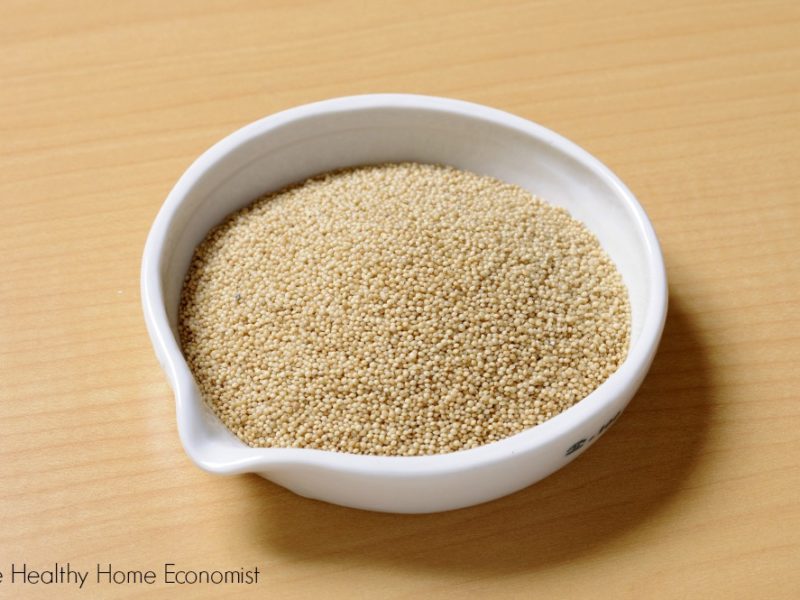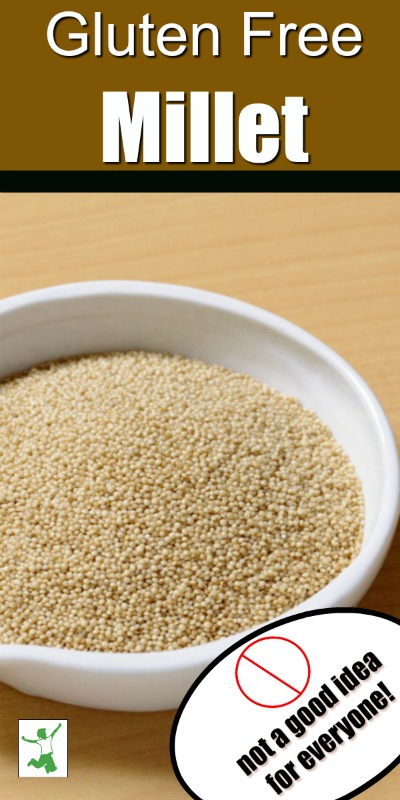Examination of why millet should optimally be eaten in moderation as a gluten-free whole grain in order to avoid disrupting hormone health.

Gluten allergies are clearly on the increase in our modern society. It seems like practically every other person I know these days has some sort of digestive issue that avoiding gluten would probably improve.
At the top of the list of gluten-containing foods is wheat. It is the indisputable, primary staple of the Western diet. Wheat is also the very foundation of the controversial USDA Food Pyramid.
Given how important bread and other wheat-based carbohydrates are to our society’s basic food requirements, it’s no wonder that folks seek a quick and easy substitute for wheat bread and wheat-based snacks when a gluten allergy or Celiac disease has been diagnosed.
Millet: Ancient Gluten-free Whole Grain
Enter millet. This ancient grain was cultivated in East Asia as far back as 10,000 years ago, according to archaeologists. Surprisingly, the cultivation of millet in prehistoric times was more prevalent than even rice, particularly in what is now China and the Korean peninsula.
Millet’s resistance to drought is perhaps the reason for its popularity in ancient times and its spread to Europe by 5000 B.C.
Despite the 5000 years cultivating this whole grain as a staple food, millet porridge is considered a traditional food in Russia as well as China. Use of millet is also widespread in Africa, like gluten-free teff, likely due to the drought-prone climate.
Millet Bread: Logical Substitute for Wheat
The protein structure of millet is quite similar to wheat. The one glaring exception is that millet is a gluten-free grain. Wheat contains copious amounts of this hard to digest plant protein.
When plain millet flour is used for baking bread (as opposed to homemade gluten-free flour or a healthy gluten-free flour mix from the store), the resulting loaf is light, white, and quite similar in texture to wheat bread. As a result, people who wish to avoid gluten tend to immediately gravitate to millet bread as the most logical and palatable substitute.
Millet bread is extremely popular in health food stores. Sami’s Bakery and Deland Bakery are two local bakeries that sell an absolute ton of millet bread to these stores around my local metro area.
I recently corresponded with a person up the East Coast of the USA who was consuming a lot of the millet/flax chips as an alternative to wheat-based snacks and had no idea of the potential health risks from consuming so much millet.
It was this discussion that led me to write this blog and warn folks about the dangers of consuming too much millet!
Potent Goitrogens
While millet does not contain gluten, it does contain goitrogens. These are substances that suppress thyroid activity and can lead to goiter. This condition involves enlargement of this very important gland which resides in the throat. Low iodine intake can also lead to goiter for those who rely on millet as a staple according to the Journal of Endocrinology and Metabolism.
Hypothyroidism is a serious and sometimes debilitating condition. It accompanies a weak or enlarged thyroid such as what occurs with goiter. Depression, difficulty losing weight, loss of hair, cold hands/feet, and fatigue are common hypothyroid symptoms. By some estimates, hypothyroidism is at epidemic proportions in Western society. (1)
Goitrogens in foods that contain them are usually reduced by cooking such as cruciferous vegetables like broccoli. However, cooking actually increases the goitrogenic effect of millet! Incidentally, the same effect occurs when fermenting soy.
Therefore, when folks begin eating large amounts of millet bread with a wholesale switch over from wheat, the thyroid suppressing effects of this simple dietary change can be profound. Injuring the thyroid can have a cascade effect on other glands as well. For example, those suffering from adrenal fatigue many times have thyroid issues as well.
Moderation is Critical
Protect your thyroid at all costs! It is a real challenge to unwind the effects of hypothyroidism once this vital gland is weakened or enlarged. Don’t take any chances with your thyroid health by consuming large amounts of millet bread or millet based snacks.
If gluten and/or wheat is a problem, then simply reduce bread consumption. Alternatively, use another grain that is both gluten-free and non-goitrogenic such as rice, oats or teff. Be sure to get quality, though, as rice is frequently high in arsenic.
Alternatively, try using grain-like gluten-free foods such as highly nutritious buckwheat, amaranth, or the starchy tuber cassava. They are excellent for baking too!
Millet bread consumption is fine in moderation if your thyroid is healthy – just don’t overdo it!
Given how difficult it is in modern society to maintain thyroid and overall glandular health, taking a chance by eating a lot of millet bread is a risky proposition indeed.
Traditional peoples did not have the constant stresses and strains on their glands like modern people do.
For example, they did not have to contend with pollution of their food, water, air and overall environment.
Therefore, we must be overprotective of our thyroid health. This includes avoiding regular consumption of foods that might impair it in any way.

Millet Alternatives That Preserve Thyroid Function
If you have thyroid issues and need alternatives to millet, here is a list of the healthiest options to consider.
- Einkorn Benefits (contains “good gluten“)
- Teff Benefits
- Yuca Root Benefits
- Arrowroot Benefits
- Wild Rice Benefits
- Farro (great if only modern wheat is the problem)








The people in my tribe eat Millet as a meal twice day and some time porridge and a drink. No goiter is preverlent in my community. Verify facts before posting
What areas of the world please? Is your statement based on fact or speculation? I am African, and cassava is a staple, yet goiter and thyroid issues are not prevalent in our society. Infact, most people who have these issues are African immigrants living in Western nations or Africans who believe they have seen the light and have now made the standard American diet their staple. Sad!
Just to further your information regarding millet, I have done a good amount of researching and have found that there are several varieties of millet – ones that can impact your thyroid (goiter) and ones that there is no evidence of an impact. When purchasing millet flour or bread, you need to find out what kind of millet was used. Pearl millet seems to cause a substantial risk of thyroid goiters, proso millet does not seem to. I am careful with the wording because while there are studies on pearl millet there are none on proso millet. I have thyroid issues and a friend who is extolling the virtues of millet bread so I started digging. In speaking with my Endo she also advised high caution with pearl millet (among others), but said her research has shown that proso seems fine. As with everything – in moderation.
This article says that some “healthy alternatives to millet” include cassava and yuca (these are names for the same thing), which is also called tapioca —
however, is it important to note that cassava/yuca/tapioca contains goitrogens, just as millet does.
They are both on many “avoid” lists, especially for people with thyroid issues.
Home cooking in the ordinary way does not reduce the goitrogens in millet or tapioca/cassava/yuca. I have read that cooking actually increases the goitrogens in millet. (Home cooking reduces somewhat the goitrogens in vegetables, so some people think that this fix applies to all foods, but it doesn’t.)
This website has a different article on cassava flour, and it claims that the processing of cassava flour deactivates the inherent goitrogens.
However, even if that is true for certain manufacturers and specific manufacturing processes, it may not be true of all manufacturers and retailers (even those who sell products in the US market), and of course, people eat tapioca/yuca/cassava in other ways, other than as a flour – they eat it as a pudding, etc.
The areas of the world which are dependent on cassava/yuca/tapioca as a main food source have for generations had problems with goiters and other thyroid issues. This goitrogen problem inherent in cassava/tapioca/yuca is probably not solved even yet today, so it may be prudent for people with thyroid issues to avoid it, even as a flour, even in “healthy” gluten-free food items.
This article doesn’t appear to cite any scientific papers. Could you please provide some as I enjoy millet and would like to further assess the risk of eating it.
I brew my own beer. If I brew a gluten free beer using millet, will it affect the thyroid as stated in the above article especially in the case of hypothyroidism.
The hair regrowth vitamin supplement Priorin contains Millet extract (3 mg per capsule). Would this be safe to use everyday?
Thanks so much! I went directly to pubmed because I take everything with a grain of salt these days. And you’re right on the money. I found out I’m Celiac and have had the genes all my life, and that’s why I looked starved and struggled as a child. I nearly died, but there was always some other explanation. The health chaos didn’t end until I found out about the Celiac. By then, my thyroid was so destroyed, it was making inactive T3, and my pancreas was barely treading water with a TG level over 500. Only being ketogenic helped that. Fast forward 4 years, still struggling a bit with keto, and bingo, the problem is, I’m celiac. Explains why keto nearly worked. This is such madness. We need to be screening people for these genes and for the associated illnesses.
That aside, I thank you for the warning about grains in general. The point is well taken. It seems like many of the things that make for the “umami” flavor are goitrogenic, so they should be treated like a dessert. Have them to make you happy once in a while, but keep them off the regular food list. Besides, fresh foods are divine. I’ve never liked any food more than I love a fresh salad with some grilled garlicky meat on top. I guess I should count my blessings because not everyone is so lucky to like that as much. I did love Millet bread for a while, but the Deland bread started making me react and I found out their facility is not as scrupulous as I thought. This article made me feel better about losing a favorite.
Give me first reliable food and nutrition without depleting natural resources and give me suppliers, that is growers and communities, who enjoy profits and other benefits associated with production of sorghum and millet.
Then, once well fed and sleeping well, if I have a problem with my diet, I will deal with it. At least I will be alive, strong and well enough to consider the larger question of food nutrition and special dietary needs.
I am thinking of the Food Security challenges of sub-Sahara African nations, India and other countries.
Good grief!!! That’s like saying “beware of broccoli” (it is a goitrogen)… Millet is awesome because it is very high in nitrilosides, which have excellent (some of the best) anti-cancer properties. So, I have to disagree with this article, and honestly, I wonder why it was written. Rubbish.
Actually, you’d better beware of broccoli unless you cook it 🙂 Scientific research finds that raw broccoli is extremely hard on digestion among other health risks and that a light cook or steam is far more beneficial and allows better absorption of nutrients. https://www.thehealthyhomeeconomist.com/reasons-to-cook-broccoli/